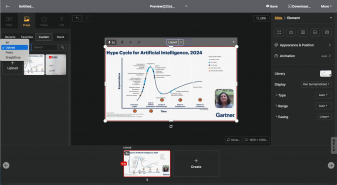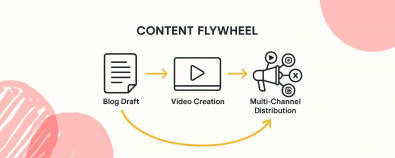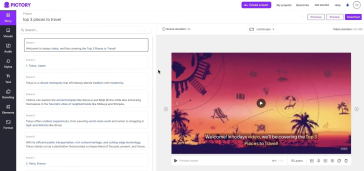
Junwoo
2024-05-21 15:08:19
University
YouTube Operation Strategy for Media Companies (feat. Media Companies Using VideoStew)
🎓
A Comprehensive Guide to Features Frequently Used by Videostew Creators
How are creators making the most of Videostew? 🤔By exploring use cases of Videostew, we've gathered insights from various creators, leading us to identify four ...

📣
Videostew Team Members Share the Journey of Our 500K Creator Client's YouTube Growth
At Videostew, we run an online chat service where real humans are ready to assist you. Among our team, whenever we talk about memorable customers, the nickname ...

🎓
Best AI Tools for Content Creation in 2025 (A Practical Guide)
Why Is It Time to Rework Your “AI Tool Stack” Now?From traditional blogs and newsletters to Instagram Reels, YouTube Shorts, TikTok videos, and even X and Threa...

🎓
What's the Best Text to Video AI for Content Marketers? 🤔
This is a sincere, elaborate, and friendly guide from Jun, the operator of Videostew, dedicated to all content marketers tirelessly searching for the “best text...

🗞️
[Update] Language Optimization for AI Voice
We are currently optimizing AI voices for each language. 🎙️Previously, if the engine was multilingual, even English voices could smoothly speak other languages....
![[Update] Language Optimization for AI Voice](https://cdn.videostew.com/files/thumb/f13322a3c-7quufcgbm)
🗞️
[Update] MP3 Download Feature
Exciting news! You can now extract audio from your project and download it as an MP3 file. 🎉Before you dive into MP3 bliss, remember to render your project firs...
![[Update] MP3 Download Feature](https://cdn.videostew.com/files/thumb/5a4b397a5-7qqka7317)
🗞️
[Update] AI Image Generation Style Selection Feature Added
You can now generate a variety of illustrations in the AI Image Generation feature under the illustration category. (Image generation feature is available for P...
![[Update] AI Image Generation Style Selection Feature Added](https://cdn.videostew.com/files/thumb/7cd54b9e3-7qndp2d2n)
📣
Videostew Success Story: Meet 'Jalhaja,' a 55-Year-Old Full-Time Homemaker and YouTube Creator with 150,000 Subscribers
From the early days of Videostew, our dedicated user ‘Jalhaja’ has been a loyal customer from our perspective. After more than a year of consistent use, we requ...

Many media outlets are striving to capture the YouTube audience as a new challenge. There's particularly great interest in short-form videos that can reach a wider potential audience.
Additionally, from this year, VideoStew has been selected as the TTV solution by the Korea Press Foundation, which means we can introduce VideoStew to even more media outlets.
So, our operations team took a deep dive into media outlets currently using VideoStew. In this post, we will share various stories from the adoption to the stabilization phase(?) of VideoStew among media outlets.
< Major media outlet customers using VideoStew >
Reasons for Media Outlets to Adopt VideoStew
At the stage of considering the adoption of VideoStew, media outlets generally showed two contrasting characteristics.
Exploring the Fastest Way to Start Anew
The first case involves media outlets that do not have a YouTube channel at all (or if they do, there’s no properly uploaded content) and want to start properly now.
Due to internal resource issues, they lack specialized personnel for video editing, so they find VideoStew while looking for the easiest way to start video-format articles.
The most common reason for adopting VideoStew was, “I don't know how to use video editing tools, but I'm familiar with PowerPoint, so I think I can use it easily.”
Revolutionizing the Efficiency of Video Production Workflow
The second case involves media outlets that have been running a YouTube channel sporadically, but the results did not justify the effort.
Typically, they say it takes a week to distribute a video after going through shooting and editing with a dedicated video team. Two issues arise from this.
First of all, it becomes impossible to turn the 5-10 articles that come out every day into videos. Separate planning for videos is required, and it moves independently of the direction of our desk. Additionally, within a week, the issue is already distant, making it difficult to capture timeliness.
Next is the issue of efficiency. Although the content is created with a week's worth of resources, the views are not as high compared to the effort put in.
Preferred by text-based media companies
Contrary to these conflicting characteristics, the common tendency observed is that traditional newspaper companies had a high demand for adoption.
The reason is that broadcast-based media already had a rich collection of video content, making their transition to YouTube smooth, whereas newspapers were not prepared for the video format.
However, with VideoStu, by simply inputting the original text, background videos, AI voice, music, sound effects, etc., are easily combined to create a video. Thus, the abundance of text material and the continuous generation of new articles were actually opportunities for newspapers.
Common pitfalls among media companies
Various media companies have adopted VideoStu for different reasons, but there are common pitfalls they encounter. In fact, I once visited a media company after feeling frustrated while watching YouTube and provided one-on-one coaching to the person in charge.
The common pitfalls media companies face can be summed up with the keywords 'using grammar suitable for videos' and 'sense of speed'.
Applying article style directly to videos
The article style used by newspapers is optimized for reading with the eyes. However, if a voice actor reads it verbatim, it creates a very awkward video content.
There was also the issue of using additional information in parentheses as is. For example, when introducing a person, a voice actor would say, "Minister Hong Gil-dong said." But in an article, it would be, "Minister Hong Gil-dong (Minister of XX Department, former Chairman of XX Committee) said," with detailed information included.
There have been numerous cases where unnecessary information is read by AI narration, making the content lengthy and less natural.
With VideoStew's [Refine Text] feature, you can transform these stiff narratives into natural conversational tones. We've been informing our media clients about this feature so they can better adapt their articles into video-friendly formats.
The Pace Misunderstood by Video Audiences
(
According to YouTube standards) Short-form videos are limited to under one minute. To convey sufficient information within this constraint, content with a sense of urgency has become the trend. Audiences have also adapted to this pace.However, some media outlets make the mistake of cramming entire paragraphs into a single slide. Even if the content is the same, how you package it with a sense of speed is what really matters.
< A design that doesn't fit the video format at all >
The VideoStew team has given this issue a lot of thought. Our goal is to allow users to create consumable, fast-paced content with minimal effort.
We offer various convenient features, including the [Apply by Line] feature, which reads text line by line, playing a crucial role in achieving this.
Tips and Success Stories for Media Companies Running Successful YouTube Channels
By examining both successful and less successful cases of media companies using VideoStew, we've identified three key tips.
If you're gearing up to venture into video channels, including YouTube, please take note.
1) One Shot, One Message
In the consulting industry, there's a term called 'one slide, one message'. It means that only one message should be included per slide.
This can be applied to short-form videos as well. Short-form videos are typically under a minute long, making it difficult to pack in too much information.
So, instead of a format that briefly introduces each section like a daily briefing, it's better to create separate videos of about 30 seconds for each section. This way, the information is more effectively conveyed, and there's more incentive to subscribe.
Although not a traditional news outlet, i-Boss is a good example. i-Boss publishes marketing news clippings daily on Facebook in a card news format. When converting these to YouTube Shorts, they use a strategy of creating separate content for each section.
< Card news style news briefing (left), YouTube Shorts with detailed content (right) >
This approach clearly understands the difference between card news, which is advantageous for quick scanning, and video media, which conveys information along with sound.
2) Creating Hook Points
Research on viewing patterns of TikTok and YouTube Shorts in 2021 shows that viewers typically decide within the first 5 seconds whether they are interested in a video.
Although there is no recent research, considering the trends in important metrics like watch time and viewer retention on YouTube, it seems that this decision time is getting shorter.
In the short-form video market, it's more important than ever to create a hook point early on to decide whether viewers will continue watching.
Watching the videos on the channel of Kukmin Ilbo's Zepeto Reporter, who recently adopted VideoStew, I noticed they are really good at capturing these hook points.
< “Which countries have a holiday for Parents' Day?” - a striking hook >
I may not have access to the Creator Studio metrics, but I dare say this content probably has a very high retention rate.
3) Insert Appropriate Images
In the flood of information, for our videos to be chosen and consumed by users, we need to edit them more diligently than ever.
If you ask, “Why should a human edit in the age of AI?”, I’d like to answer this way:
With AI video editing solutions like VideoStu becoming commercialized, this quality has now become the standard. Anyone can produce the same quality as you if they have the text.
Therefore, media companies need to make more effort to stand out. Fortunately, the advantage of VideoStu is that it offers various tools to minimize the time required for such editing efforts. (According to internal research, assuming the same content production, using VideoStu reduces production time by 75% compared to Premiere.)
One of the most effective editing efforts (i.e., showing sincerity) you can make is to actively utilize your image resources.
Generally, media companies either have a lot of their own images or acquire them through contracts with agencies. Showing the right images that match the articles and paying more attention to visualization is the best way to highlight the uniqueness of your content.
< Issue-ing operated by Asia Times >
Conclusion
We have explored the adoption and utilization cases of media companies that have integrated VideoStew, and summarized tips for developing YouTube channel operation strategies through these cases.
To run a successful YouTube channel, merely using tools is not enough. Creating content that adheres to video grammar, delivering information at a brisk pace, and setting hooking points were crucial.
Moreover, even when using AI editing solutions, combining human creativity and editing efforts is essential to produce differentiated content.
We hope this post helps media professionals considering venturing into video channels, and we look forward to returning with in-depth interview content on media companies actively using VideoStew next time! Thank you.